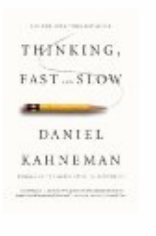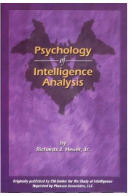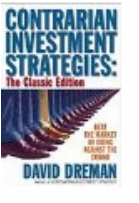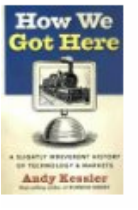| | Today I am speaking with Tom Fogarty, a sixteen-year Wall Street veteran, who is a Senior Securities Analyst at Dreman Value Management. Prior to Dreman Tom worked for Silverstone Capital, a market-neutral hedge fund that focused on autos and auto related industries. He also worked at UBS, as an Associate Director of Equity Strategy where he helped to pick stocks for the Select 20 portfolio. Tom got his start in the business as a credit analyst at Moody's Investors Service. So Tom, What's in your Library?  Thinking Fast And Slow by Daniel Kahneman - An accessible compedium of behavioral economics by a pioneer in the field, who is also a Nobel Laureate. If you've ever had trouble accepting that economic agents aren't entirely rational...read this! It also covers why people are bad intuitive statisticians and some methods for doing better. In the section on mean regression, Kahneman presents his equations for success:
- Success = Talent + luck!
- Great Success = A little more talent + a lot of luck!
I am always amazed at how many greatly successful people seem to forget the second term!
 The Psychology Of Intelligence Analysis by Richard Heuer - Although written by a CIA officer for intelligence analysts, the book is still completely relevant for security analysis. It addresses common cognitive biases and strategies to mitigate them. It was written in the 1990's and is a practical guide to making better inferences from the available facts.
 Contrarian Investment Strategy: The Next Generation by David Dreman - David Dreman's second most recent edition presents numerous quantitative studies that show markets are not efficient in the strict sense and thus present opportunities of excess return. He also shows that there are behavioral biases that contribute to the persistence of these sources of excess return.
 How We Got Here: A Slightly Irreverent History of Technology & Markets by Andy Kessler - Kessler made it big running a tech fund, which he shutdown at nearly the peak of the bubble. He then started writing his experiences in a series of worthwhile reads. This book picks up where Running Money leaves off; Telling an offbeat history of innovation and economic progress from the Industrial Revolution through the Nasdaq bust.
 The Flaw Of Averages by Sam Savage - The basic premise of this book is that "plans based on average assumptions are wrong on average." Instead, when faced with decisions that involve risk (where mean and variance are known) and uncertainty (where the statistical properties are unknown) we should think in terms of distributions, not averages. This book is full of interesting applications and examples. To get a flavor of the main premise, I'd highly recommend Steven J. Gould's three-page essay "The Median Isn't The Message"
 The Dhandho Investor by Monish Pabrai - This is the book I usually recommend to people with a new-found interest in the stock market. it's a practical guide to real-world value investing, stressing asymmetric return profiles and smart risk taking. It also explains why so many roadside hotel owners are named Patel. If people make it through Pabrai's book, I usually follow up with Howard Mark's "The Most Important Thing". It is more sophisticated, and gives a better sense of the competition for returns. It clearly expresses that there is no silver bullet...That investment success takes hard work and is a process of balancing a web of factors that are often polar opposites. I also love his respect for uncertainty.
Thanks Tom.
As always you can buy any of the books Tom mentioned at the The Sniper Book Bin. If you'd like to see another great read, sign up for The Sure Shot Letter, my monthly newsletter that is packed full with great investment ideas. Hit the button at the top of the page for a free sample, and/or subscribe here.
|
Many of you have been asking me to see a sample of my newsletter, The Sure Shot Letter. This week, I am providing a sample issue. Click on the Sample Issue button at the top of the page to be taken to your free issue.
| | Given the popularity of my full-length interview with Samuel Eisenstadt, I have decided to include other full-length interviews on topics that capture my attention. Today I am interviewing Leigh Drogen, CEO of Estimize. In a nutshell, the company offers a broader consensus estimate that is oftentimes more accurate than the traditional consensus estimate. With that said, on to the Q&A with Leigh! Question: What is Estimize?
Answer: Estimize is a web site where buy side and independent analysts contribute their earnings and revenue estimates for publicly traded companies. The best way I like to describe it to people within the financial world is that Estimize is what you would get if you built I/B/E/S and Starmine from the ground up with a radically open philosophy, and then attracted an amazing community to contribute who did not suffer from the same conflicts as sell side analysts. By using a couple of smart algorithms to make sure the data set is incredibly clean, we’re able to take estimate models from senior buy side hedge fund analysts all the way down to MBA students. The Estimize platform is not so much concerned with the rationale behind the analyst’s estimate models as it is the accuracy of those estimates. By having this rationale agnostic view we’re able to look at an analyst from a purely statistical level and we’re now able to predict with a scary degree of accuracy which analysts will be the most accurate in the future. I like to think of Estimize as having a Moneyball type philosophy, and to be honest that scares some people just as it did in Major League Baseball. But we know that when it comes to the direction that data sets like these are moving, we’re on the right curve.
Question: What differentiates the Estimize data set from sell-side estimate data sets?
Answer: The most important aspect is that we’re sourcing estimates from a wider set of individuals. Whereas I/B/E/S gets estimates from about 300 different sell side firms, we have over 2,800 contributing analysts from a range of different backgrounds. We have buy side analysts from prominent hedge funds, professional independent analysts from independent research firms, corporate finance professionals, students, individual traders, etc. Basic crowdsourcing theory states that the broader the range of independent views you have into a consensus the more accurate that consensus will be, and we’ve definitely seen that. Our mean consensus, without weighting any individuals greater than others, is more accurate than comparable sell-side data sets 69% of the time, and 14% more accurate on average. This isn’t surprising as our community of analysts do not have the same skewed incentive structures as the sell side analysts which lead them to be less accurate. But more importantly in my opinion, is that our consensus estimates better represent the true expectations of the market, which allows investment professionals to better manage risk by being able to understand where their expectation lies in relation to the true expectation of the market. We’ve run studies that show our consensus estimates are higher correlated to how the market treats a stock after a company reports. Last quarter we had coverage on 931 names, and having more accurate, more representative data is a huge win for a range of different investors who use estimates as an input to their strategies.
Question: Are you looking to expand the Estimize platform into other data sets such as margins?
Answer: Definitely. As the community grows and we fill out our coverage for the core EPS and Revenue data sets, we’ll begin to expand into other metrics. Margins and EBITDA are natural extensions of our core set, and from there we’ll look to add business line items for each company such as iPads and iPhones for Apple. Beyond that, we definitely have our eye on international, as well as totally different data sets such as macro economic numbers, fixed income, and basically any other metrics that you find on a Bloomberg machine. The infrastructure we’ve built and the algorithms that help to provide the analytical layer are very flexible and easily replicated for other data sets.
Question: What differentiates Estimize from “whisper number” services which have been around for a while?
Answer: Great question. A “whisper number” is inherently an opaque secret number by the nature of how it’s created. A sell side equity sales guy will call up a buy side analyst and ask him what his actual expectation is for the company, and the sell side analyst will kind of relay what he’s heard from other buy side guys, as well as try and give some insight from their sell side analyst on an off the record basis. This whole thing sucks because there’s zero accountability and it’s just down right inefficient. Whisper number web sites act the same way, people come to the site, they put in numbers, and out pops this whisper number that no one has a clue how it was created. For all anyone knows the people who run these sites could just be making it up themselves. While we allow analysts on Estimize to use a pseudonym for compliance purposes, they create their estimate models under one account, that everyone can see, and all of their estimates are scored and ranked. When you look at an upcoming earnings release for a specific stock, you see all of the estimates from every analyst right there in plain sight. You know exactly what went into that consensus number. You can also find the most accurate analysts and look at their individual estimates, which isn’t possible through these whisper number sites. We believe we’re operating the platform with a far better philosophy and the outcome is a better data set for everyone.
Question: Where are the company and the platform headed over the next 18 months?
Answer: We’re extremely focused right now on building out the community of contributing analysts. A good portion of our engineering and business resources are going straight towards that effort. Our other resources are going towards building that Starmine type analysis layer such as user confidence scores and a Select Consensus, along with notifications, a groups feature and other tools that support the process that analysts go through with this data set. But primarily we’re reaching out directly to analysts, PMs, and directors of research at hedge funds and asset management firms, getting into their circles, and showing them the value of using Estimize to track their estimates and incorporate our data into their strategies.
We’ve seen some really good progress over the last few months and in my opinion every contributor to the platform is highly incented to get her peers to contribute as well as it provides them with a better data set at the end of the day. We’re also working on forming partnerships with large financial data and financial media platforms. We recently announced our partnership with Bloomberg which was a big step, and you’re going to see our data and research reports on several other large platforms real soon. As an aside, we always appreciate when the analysts on the site give their reps at companies like Factset, Capital IQ, Bloomberg, or Thomson a ring and request our data to be available via their services, it helps move along the process quicker.
Question: How does Estimize make money if the site is completely free to use?
Answer: Ah, the million dollar (or hopefully more) question. Because we want the data set to be available to everyone we don’t charge for access on the site. But when it comes to viewing our data anywhere away from our site, or being able to download and manipulate our data, that’s where we charge. We have an API that allows quant traders to take a real time feed of all of the estimates and some other analytics and build models with that data. We charge a multiple of what I/B/E/S or Starmine do, largely because you can’t get our data anywhere else, it’s more accurate, and the alpha generating capability hasn’t been arbitraged out as it has been with the sell side data sets. Thanks Leigh. On a separate note, Estimize will be sponsoring the 1st Annual Value Line Alumni Reunion on June 13th, at the Bryant Park Grill. Come out and meet Leigh after work on June 13th. |
|







 RSS Feed
RSS Feed
